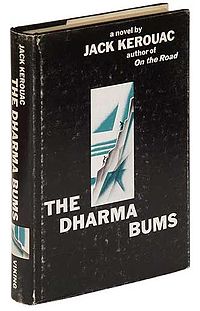- The Dharma Bums
-
The Dharma Bums
1st editionAuthor(s) Jack Kerouac Country United States Language English Genre(s) Novel Publisher The Viking Press Publication date 1958 Media type Print (Hardback & Paperback) Pages Approx. 435 pp ISBN 0-14-004252-0 OCLC Number 23051682 Dewey Decimal 813/.54 20 LC Classification PS3521.E735 D48 1990 Preceded by The Subterraneans
(1958)Followed by Doctor Sax
(1959)- This is an article about the novel by Jack Kerouac. For the band, see Dharma Bums.
The Dharma Bums is a 1958 novel by Beat Generation author Jack Kerouac. The semi-fictional accounts in the novel are based upon events that occurred years after the events of On the Road. The main characters are the narrator Ray Smith, based on Kerouac, and Japhy Ryder, based on the poet and essayist Gary Snyder, who was instrumental in Kerouac's introduction to Buddhism in the mid-1950s. The book largely concerns duality in Kerouac's life and ideals, examining the relationship that the outdoors, bicycling, mountaineering, hiking and hitchhiking through the West had with his "city life" of jazz clubs, poetry readings, and drunken parties.
One episode in the book features Smith, Ryder and Henry Morley (based on real-life friend John Montgomery) climbing Matterhorn Peak in California. It tells the story of Kerouac's first introduction to this type of mountaineering and would serve as inspiration for him to spend the following summer as a fire lookout for the United States Forest Service on Desolation Peak in Washington. The novel also gives an account of the legendary 1955 Six Gallery reading, where Allen Ginsberg gave a debut presentation of his poem "Howl" (changed to "Wail" in the book), and other authors such as Snyder, Kenneth Rexroth, Michael McClure, and Philip Whalen performed.
Contents
Plot summary
Ray Smith's story is driven by Japhy, whose penchant for the simple life and Zen Buddhism greatly influenced Kerouac on the eve of the sudden and unpredicted success of On the Road. The action shifts between the events of Smith and Ryder's "city life," such as three-day parties and enactments of the Buddhist "Yab-Yum" rituals, to the sublime and peaceful imagery where Kerouac seeks a type of transcendence. The novel concludes with a change in narrative style, with Kerouac working alone as a fire lookout on Desolation Peak (adjacent to Hozomeen Mountain), in what would soon be declared North Cascades National Park (see also Desolation Angels). These elements place The Dharma Bums at a critical junction foreshadowing the consciousness-probing works of several authors in the 1960s such as Timothy Leary and Ken Kesey.[citation needed]
Character Key
"Because of the objections of my early publishers I was not allowed to use the same personae names in each work." [2]Rol Sturlason
Real-life person Character name Jack Kerouac Ray Smith Caroline Kerouac Nin Carolyn Cassady Evelyn Neal Cassady Cody Pomeray Claude Dalenberg Bud Diefendorf Allen Ginsberg Alvah Goldbook Natalie Jackson Rosie Buchanan Philip Lamantia Francis DaPavia Michael McClure Ike O'Shay Locke McCorkle Sean Monahan John Montgomery Henry Morley Peter Orlovsky George Kenneth Rexroth Rheinhold Cacoethes Gary Snyder Japhy Ryder Alan Watts Arthur Whane Philip Whalen Warren Coughlin But, Kerouac was not always conscientious about masking the identities of his friends. At the end of Chapter 23, he says "I had a dollar left and Gary was waiting for me at the shack."
Reception
Some reviewers criticized Dharma Bums for being spiritually crude and lacking seriousness. Ruth Fuller Sasaki found it a good portrait of Snyder, but thought Kerouac knew nothing about Buddhism.
Snyder wrote Kerouac, "Dharma Bums is a beautiful book, & I am amazed & touched that you should say so many nice things about me because that period was for me really a great process of learning from you...." but confided to Philip Whalen, "I do wish Jack had taken more trouble to smooth out dialogues, etc. Transitions are rather abrupt sometimes."[3] Later, Snyder chided Kerouac for the book's misogynistic interpretation of Buddhism.[4]
See also
Notes
References
- Kerouac, Jack. The Dharma Bums (1958) ISBN 0-14-004252-0
- Stirling, Isabel. "Zen Pioneer: The Life & Works of Ruth Fuller Sasaki" (2006) Shoemaker & Hoard. ISBN 978-1-59376-110-3
- Suiter, John. Poets on the Peaks (2002) Counterpoint. ISBN 1582431485; ISBN 1-58243-294-5 (pbk)
Works by Jack Kerouac Fiction The Town and the City (1950) · On the Road (1957) · The Subterraneans (1958) · The Dharma Bums (1958) · Doctor Sax (1959) · Maggie Cassidy (1959) · Book of Dreams (1960) · Tristessa (1960) · Visions of Cody (1960) · Lonesome Traveler (1960) · Big Sur (1962) · Visions of Gerard (1963) · Desolation Angels (1965) · Satori in Paris (1966) · Vanity of Duluoz (1968) · Pic (1971) · Orpheus Emerged (2002) · And the Hippos Were Boiled in Their Tanks (2008; with William S. Burroughs)Poetry Mexico City Blues (1959) · The Scripture of the Golden Eternity (1960) · Scattered Poems (1971) · Old Angel Midnight (1973) · Book of Haikus (2003) · Book of Sketches (2006)Other books Atop an Underwood: Early Stories and Other Writings (1991) · Good Blonde & Others (1993) · Beat Generation (2005)Audio Poetry for the Beat Generation (1959) · Blues and Haikus (1960) · Readings by Jack Kerouac on the Beat Generation (1960) · The Jack Kerouac Collection (1990) · Jack Kerouac Reads On the Road (1999)Bibliography · Duluoz Legend Categories:- 1958 novels
- Novels by Jack Kerouac
- Books about the Beat Generation
- Roman à clef novels
Wikimedia Foundation. 2010.

